Books by Estelle Strazdins
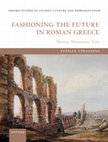
https://global.oup.com/academic/product/fashioning-the-future-in-roman-greece-9780192866103?lang=... more https://global.oup.com/academic/product/fashioning-the-future-in-roman-greece-9780192866103?lang=en&cc=au
Order via global.oup.com with code AAFLYG6 for 30% discount
Fashioning the Future in Roman Greece: Memory, Monuments, Texts uses literature, inscriptions, art, and architecture to explore the relationship of elite Greeks of the Roman imperial period to time. This wide-ranging work challenges conventional thinking about the temporal positioning of imperial Greece and the so-called 'Second Sophistic', which holds that it was obsessed above all with the Classical past. Instead, the volume establishes that imperial Greek temporality was far more complex than scholarship has previously allowed by detailing how contemporary cultural output used the past to position itself within tradition but was crafted to speak to the future. At the same time, the book emphasizes the value of interdisciplinary analysis in any explication of elite culture in Roman Greece, since abundant extant evidence reveals its purveyors were often responsible for the production of both literature and material culture. Strazdins shows how these two modes of cultural production in the hands of elites, such as Herodes Atticus, Arrian, Aelius Aristides, Lucian, Dio Chrysostom, Polemon, Pausanias, and Philostratus, exhibit a shared rhetoric oriented towards posterity and informed by a heightened awareness of the fragility of cultural and personal memory over large spans of time. The book thus provides a sophisticated analysis of the tensions, anxieties, and opportunities that attend the fashioning of commemorative strategies against the background of the 'Second Sophistic' and the Roman empire, and details the consequences of embroilment with futurity on our understanding of the cultural and political concerns of elite imperial Greeks.
Peer-Reviewed Articles by Estelle Strazdins
Classical Philology 114.2, 2019
Contact me for a copy
Comparative Critical Studies, 2005
Post-print version, accepted published by Edinburgh University Press in Comparative Critical Stud... more Post-print version, accepted published by Edinburgh University Press in Comparative Critical Studies 2.2 (2005Studies 2.2 ( ), 285-295. https://www.euppublishing.com/doi/abs/10.3366/ccs.2005 Transforming Fire: The Effect of Technology on Humanity in Hesiod's Prometheus
Chapters by Estelle Strazdins

Travel and Classical Antiquities in Nineteenth-Century Ottoman Greece, 2024
This chapter traces responses to flakes of obsidian which were found in the Marathon soros by nor... more This chapter traces responses to flakes of obsidian which were found in the Marathon soros by northern European travellers from the late eighteenth and the nineteenth century and which were initially interpreted as flint arrowheads belonging to Ethiopians who fought in the famous battle of 490 BCE. It argues that these “arrowheads” were central to creating a tangible link for the travellers between the battle of Marathon and aspirations for the freedom of Greece from Ottoman rule, and that they largely determined interpretations of the contents of the Marathon soros, even after official excavations at the end of the nineteenth century. At the same time, the plain was idealised as a place of agriculture rather than conflict by the travellers, and local populations were denied a voice in explicating its meaning. Nevertheless, hints of attitudes towards the soros or to Ethiopians held by locals and more marginal figures are uncovered in travel accounts, in communications from indigenous groups, in folklore traditions, and in official edicts from the new Greek government.
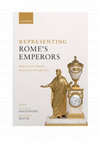
Please contact me for a copy!
Abstract
This chapter examines Herodes Atticus’ use of imperial im... more Please contact me for a copy!
Abstract
This chapter examines Herodes Atticus’ use of imperial images against the backdrop of his broader monumentalizing programme in Roman Greece. In particular, it draws out the implications of how Hadrian and Antinous, and Marcus Aurelius and Lucius Verus are represented and displayed in a series of portrait busts commissioned by Herodes and arranged in his private villa at Loukou-Eva Kynouria or in the public sanctuary of Nemesis at Rhamnous in Attica. These images are integrated into a broader visual, cultural, and historical programme that recasts the power relationships between Romans and Greeks in the eastern empire. The chapter argues that Herodes employs these portraits of contemporary emperors to assert his own centrality to the maintenance and mediation of Roman imperial power in the province of Achaea, and that this message complements the contemporary promotion of Greek culture evident in the ‘Second Sophistic’ more broadly.
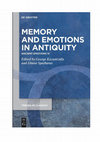
Please contact me for a copy!
Abstract: Herodes Atticus is known as much for his outrageous grie... more Please contact me for a copy!
Abstract: Herodes Atticus is known as much for his outrageous grief as for his impressive attempts to build himself into the cityscapes and memorial landscapes of the eastern Roman empire. This chapter examines some of Herodes’ more personal monuments — curse-inscribed herms of his foster sons and the Gate of Eternal Concord — within the context of their spatial relationships, Herodes’ personal commemorative programme, and his own theorising on apatheia and pathê reported in Gellius’ Attic Nights. I argue that Herodes’ private memorialisation is designed to materialise his grief and transfer it to the viewer in an effort to overwrite existing cultural meaning attached to commemorative landscapes with his own legacy. Nevertheless, these attempts both prove unsatisfactory to Herodes himself, because they fail to conquer the cause of his grief — i.e. death — and they are received cynically by his contemporaries, who remain unconvinced by his emotion and the identity he shapes through it.

Xenophon’s Anabasis and its Reception, T. Rood and M. Tamiolaki (eds), 2022
Contact me for a copy!
This chapter concentrates on Arrian’s apparent refurbishment of a monum... more Contact me for a copy!
This chapter concentrates on Arrian’s apparent refurbishment of a monument to Hadrian at Trapezus on the Black Sea that opens his Periplus (1.1–4) and Alexander’s interaction with Achilles’ grave at Troy in his Anabasis in the context of both Arrian’s ‘Second Preface’ (1.12.1–5) and the Ten Thousand’s thanks-giving cairn on Mt. Theches that marks their first sight of the sea in Xenophon’s Anabasis (4.7.24). I demonstrate that a) there is a relationship between these Arrian passages that hinges on Xenophon’s Anabasis, and b) Arrian exploits the materiality, spatiality, and temporality of monuments, combined with their semantic fluidity, to assert his literary authority over Xenophon, spatial authority over Trapezus, personal authority over Hadrian’s image and Alexander’s memory, and to muse on the fickleness of reception by posterity.
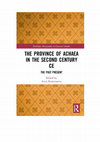
The Province of Achaea in the Second Century CE: The Past Present (A. Kouremenos, ed.), 2022
Contact me for a copy!
This chapter examines how Herodes Atticus shapes his and his family’s r... more Contact me for a copy!
This chapter examines how Herodes Atticus shapes his and his family’s role in Roman Achaea through dedications and benefactions to its many important sanctuaries. I argue that Herodes’ monumental vision not only signals inheritance of the Greek past but also the continuing vibrancy of Greek culture, as well as the dependency of Roman power on Greek elites. Herodes’ dedications focus both on religious sites of panhellenic significance, such as Olympia, Delphi, and Isthmia, and on local Attic shrines with rich religious and cultural traditions, such as Eleusis, Brauron, and Rhamnous. At panhellenic sites, his large-scale benefactions are dynastic in intent and use the Greek past to cast his family as mediators and even shapers of imperial power in the province. Similar provocative messages can be traced at more Attic-centric sites like Rhamnous, which was so closely tied to the notion of Greek freedom via its powerful association with the Athenian victory over the Persians at Marathon in 490 BCE. That he dedicates a small-scale personal monument to his foster-son Polydeukion at Brauron, moreover, which was largely abandoned in the second century, reveals a particularly broad vision of his own place in history.
Theses by Estelle Strazdins
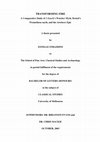
Honours Thesis, University of Melbourne, 2003
In Hebrew, Greek and Assyro-Babylonian myth, fire is a liminal element of divine origin which pos... more In Hebrew, Greek and Assyro-Babylonian myth, fire is a liminal element of divine origin which possesses the ability to transform. This thesis examines the transformative action of both transgressive fire (i.e. fire which leaves heaven without the sanction of the supreme-being) and sanctioned fire (i.e. the fire of god) on humanity, the gods and the cosmos. Transgressive fire instigates cosmic instability by promoting the negative aspects of its dichotomous nature in the transformations it performs, a process which causes the human and the divine to become confused. This unstable situation is rectified by the combined forces of the Great Flood and a Flood hero who wields sanctioned fire. By this means, cosmic stability is restored and a symbiotic relationship is established between men and gods. The influence of fire on the relationship between men and gods is studied in the Watcher myth of 1 Enoch, the Atrahasis epic, Hesiod’s myth of Prometheus, and related literature.

This thesis explores the anxieties and opportunities that attend fame and posterity in the second... more This thesis explores the anxieties and opportunities that attend fame and posterity in the second sophistic and how they play out in both literary and monumental expressions of cultural production. I consider how elite provincials in the Roman empire, who are competitive, bi- or even tri-cultural, status-driven, often politically active, and engaged in cultural production, attempt to construct a future presence for themselves either through the composition of literature that is aimed (at least in part) at the future or through efforts to write themselves into the landscape of their native or adopted cities. I argue that the cultural and temporal perspective of these men drives their multifarious, playful, and self-reflexive approach to the production of literature or monuments. For those men engaged in the ‘second sophistic’, in the narrower, Philostratean definition, there is an ever present tether on their creative efforts, in that for contemporary success they must immerse themselves in the culture of classical Athens; and the prominent practice of epideictic oratory, with its promotion of improvisation and lack of repetition, discourages the kind of literary effort that aims at eternity. At the same time, their attempts to build themselves into the hearts of cities is less restricted, in that those who possess or have access to sufficient wealth can grant elaborate benefactions which essentially stand as monuments to their financer. Nevertheless, their belated position with respect to the Greek literary canon and the heights of political and cultural prestige invested in classical Greece infuses the cultural efforts of the second sophistic with a sense of pathos that acknowledges the impossibility of creating and controlling one’s future reputation regardless of how much effort is applied. At the same time, this impossible position, rather than limiting them, endows these men with a varied, self-ironizing, intertextual, intermedial, and unique approach to cultural production that actively engages with the inescapable and laudable past in order to carve a lasting impression on the literary and physical landscape of the Roman empire.
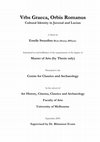
This thesis studies Greek and Roman cultural identity in the Saturae of Juvenal and what, for the... more This thesis studies Greek and Roman cultural identity in the Saturae of Juvenal and what, for the sake of brevity, I call the ‘Roman’ works of Lucian, namely De Mercede Conductis, Apologia and Nigrinus. It attempts to place these texts’ cultural references in their social, historical and political contexts in order to gain some insight into the cultural milieu of the Roman empire in the second century CE. My primary argument is that in these works cultural identity, particularly whether one identifies as ‘Greek’ or ‘Roman’, is mutable, and satire is its natural playground. The characters in both authors’ works claim specific identities, but concurrently undermine and invert them so that it becomes difficult to determine exactly which qualities define a Greek or Roman – even those who seem certain of their cultural identity can be exposed as simply playing a part. Additionally, neither author’s works are consistent in their attitudes towards different ethnicities, a fact which underscores the flexibility of cultural identity in these texts. (MA Thesis, 40,000 words)
Conference Proceedings Papers by Estelle Strazdins
Uluslararasi Samsatli Lucianus Sempozyumu/International Symposium on Lucianus of Samosata, 2008
Talks by Estelle Strazdins
Research presentation at the Australian Archaeological Institute at Athens, June 2018.
Edited Volumes by Estelle Strazdins

Routledge, 2022
This volume explores the conception and utilization of the Greek past in the Roman province of Ac... more This volume explores the conception and utilization of the Greek past in the Roman province of Achaea in the 2nd century CE, and the reception of the artistic, cultural, and intellectual outputs of this century in later periods. Achaea, usually defined by international scholars as “old Greece”, was the only Roman province located entirely within the confines of the Modern Greek state, as the other five (Macedonia, Epirus, Thracia, Asia, and Creta-Cyrenaica) spill over into neighboring countries, or in the case of the latter, across the Mediterranean Sea. In many ways, Achaea in the 2nd century CE witnessed a second Golden Age, one based on collective historical nostalgia under Roman protection and innovation. As this century has produced the highest percentage of archaeological and literary material from the Roman period in the province under consideration, the time is ripe to position it more firmly in the academic discourse of studies of the Roman Empire.











Uploads
Books by Estelle Strazdins
Order via global.oup.com with code AAFLYG6 for 30% discount
Fashioning the Future in Roman Greece: Memory, Monuments, Texts uses literature, inscriptions, art, and architecture to explore the relationship of elite Greeks of the Roman imperial period to time. This wide-ranging work challenges conventional thinking about the temporal positioning of imperial Greece and the so-called 'Second Sophistic', which holds that it was obsessed above all with the Classical past. Instead, the volume establishes that imperial Greek temporality was far more complex than scholarship has previously allowed by detailing how contemporary cultural output used the past to position itself within tradition but was crafted to speak to the future. At the same time, the book emphasizes the value of interdisciplinary analysis in any explication of elite culture in Roman Greece, since abundant extant evidence reveals its purveyors were often responsible for the production of both literature and material culture. Strazdins shows how these two modes of cultural production in the hands of elites, such as Herodes Atticus, Arrian, Aelius Aristides, Lucian, Dio Chrysostom, Polemon, Pausanias, and Philostratus, exhibit a shared rhetoric oriented towards posterity and informed by a heightened awareness of the fragility of cultural and personal memory over large spans of time. The book thus provides a sophisticated analysis of the tensions, anxieties, and opportunities that attend the fashioning of commemorative strategies against the background of the 'Second Sophistic' and the Roman empire, and details the consequences of embroilment with futurity on our understanding of the cultural and political concerns of elite imperial Greeks.
Peer-Reviewed Articles by Estelle Strazdins
Chapters by Estelle Strazdins
Abstract
This chapter examines Herodes Atticus’ use of imperial images against the backdrop of his broader monumentalizing programme in Roman Greece. In particular, it draws out the implications of how Hadrian and Antinous, and Marcus Aurelius and Lucius Verus are represented and displayed in a series of portrait busts commissioned by Herodes and arranged in his private villa at Loukou-Eva Kynouria or in the public sanctuary of Nemesis at Rhamnous in Attica. These images are integrated into a broader visual, cultural, and historical programme that recasts the power relationships between Romans and Greeks in the eastern empire. The chapter argues that Herodes employs these portraits of contemporary emperors to assert his own centrality to the maintenance and mediation of Roman imperial power in the province of Achaea, and that this message complements the contemporary promotion of Greek culture evident in the ‘Second Sophistic’ more broadly.
Abstract: Herodes Atticus is known as much for his outrageous grief as for his impressive attempts to build himself into the cityscapes and memorial landscapes of the eastern Roman empire. This chapter examines some of Herodes’ more personal monuments — curse-inscribed herms of his foster sons and the Gate of Eternal Concord — within the context of their spatial relationships, Herodes’ personal commemorative programme, and his own theorising on apatheia and pathê reported in Gellius’ Attic Nights. I argue that Herodes’ private memorialisation is designed to materialise his grief and transfer it to the viewer in an effort to overwrite existing cultural meaning attached to commemorative landscapes with his own legacy. Nevertheless, these attempts both prove unsatisfactory to Herodes himself, because they fail to conquer the cause of his grief — i.e. death — and they are received cynically by his contemporaries, who remain unconvinced by his emotion and the identity he shapes through it.
This chapter concentrates on Arrian’s apparent refurbishment of a monument to Hadrian at Trapezus on the Black Sea that opens his Periplus (1.1–4) and Alexander’s interaction with Achilles’ grave at Troy in his Anabasis in the context of both Arrian’s ‘Second Preface’ (1.12.1–5) and the Ten Thousand’s thanks-giving cairn on Mt. Theches that marks their first sight of the sea in Xenophon’s Anabasis (4.7.24). I demonstrate that a) there is a relationship between these Arrian passages that hinges on Xenophon’s Anabasis, and b) Arrian exploits the materiality, spatiality, and temporality of monuments, combined with their semantic fluidity, to assert his literary authority over Xenophon, spatial authority over Trapezus, personal authority over Hadrian’s image and Alexander’s memory, and to muse on the fickleness of reception by posterity.
This chapter examines how Herodes Atticus shapes his and his family’s role in Roman Achaea through dedications and benefactions to its many important sanctuaries. I argue that Herodes’ monumental vision not only signals inheritance of the Greek past but also the continuing vibrancy of Greek culture, as well as the dependency of Roman power on Greek elites. Herodes’ dedications focus both on religious sites of panhellenic significance, such as Olympia, Delphi, and Isthmia, and on local Attic shrines with rich religious and cultural traditions, such as Eleusis, Brauron, and Rhamnous. At panhellenic sites, his large-scale benefactions are dynastic in intent and use the Greek past to cast his family as mediators and even shapers of imperial power in the province. Similar provocative messages can be traced at more Attic-centric sites like Rhamnous, which was so closely tied to the notion of Greek freedom via its powerful association with the Athenian victory over the Persians at Marathon in 490 BCE. That he dedicates a small-scale personal monument to his foster-son Polydeukion at Brauron, moreover, which was largely abandoned in the second century, reveals a particularly broad vision of his own place in history.
Theses by Estelle Strazdins
Conference Proceedings Papers by Estelle Strazdins
Talks by Estelle Strazdins
Edited Volumes by Estelle Strazdins
Order via global.oup.com with code AAFLYG6 for 30% discount
Fashioning the Future in Roman Greece: Memory, Monuments, Texts uses literature, inscriptions, art, and architecture to explore the relationship of elite Greeks of the Roman imperial period to time. This wide-ranging work challenges conventional thinking about the temporal positioning of imperial Greece and the so-called 'Second Sophistic', which holds that it was obsessed above all with the Classical past. Instead, the volume establishes that imperial Greek temporality was far more complex than scholarship has previously allowed by detailing how contemporary cultural output used the past to position itself within tradition but was crafted to speak to the future. At the same time, the book emphasizes the value of interdisciplinary analysis in any explication of elite culture in Roman Greece, since abundant extant evidence reveals its purveyors were often responsible for the production of both literature and material culture. Strazdins shows how these two modes of cultural production in the hands of elites, such as Herodes Atticus, Arrian, Aelius Aristides, Lucian, Dio Chrysostom, Polemon, Pausanias, and Philostratus, exhibit a shared rhetoric oriented towards posterity and informed by a heightened awareness of the fragility of cultural and personal memory over large spans of time. The book thus provides a sophisticated analysis of the tensions, anxieties, and opportunities that attend the fashioning of commemorative strategies against the background of the 'Second Sophistic' and the Roman empire, and details the consequences of embroilment with futurity on our understanding of the cultural and political concerns of elite imperial Greeks.
Abstract
This chapter examines Herodes Atticus’ use of imperial images against the backdrop of his broader monumentalizing programme in Roman Greece. In particular, it draws out the implications of how Hadrian and Antinous, and Marcus Aurelius and Lucius Verus are represented and displayed in a series of portrait busts commissioned by Herodes and arranged in his private villa at Loukou-Eva Kynouria or in the public sanctuary of Nemesis at Rhamnous in Attica. These images are integrated into a broader visual, cultural, and historical programme that recasts the power relationships between Romans and Greeks in the eastern empire. The chapter argues that Herodes employs these portraits of contemporary emperors to assert his own centrality to the maintenance and mediation of Roman imperial power in the province of Achaea, and that this message complements the contemporary promotion of Greek culture evident in the ‘Second Sophistic’ more broadly.
Abstract: Herodes Atticus is known as much for his outrageous grief as for his impressive attempts to build himself into the cityscapes and memorial landscapes of the eastern Roman empire. This chapter examines some of Herodes’ more personal monuments — curse-inscribed herms of his foster sons and the Gate of Eternal Concord — within the context of their spatial relationships, Herodes’ personal commemorative programme, and his own theorising on apatheia and pathê reported in Gellius’ Attic Nights. I argue that Herodes’ private memorialisation is designed to materialise his grief and transfer it to the viewer in an effort to overwrite existing cultural meaning attached to commemorative landscapes with his own legacy. Nevertheless, these attempts both prove unsatisfactory to Herodes himself, because they fail to conquer the cause of his grief — i.e. death — and they are received cynically by his contemporaries, who remain unconvinced by his emotion and the identity he shapes through it.
This chapter concentrates on Arrian’s apparent refurbishment of a monument to Hadrian at Trapezus on the Black Sea that opens his Periplus (1.1–4) and Alexander’s interaction with Achilles’ grave at Troy in his Anabasis in the context of both Arrian’s ‘Second Preface’ (1.12.1–5) and the Ten Thousand’s thanks-giving cairn on Mt. Theches that marks their first sight of the sea in Xenophon’s Anabasis (4.7.24). I demonstrate that a) there is a relationship between these Arrian passages that hinges on Xenophon’s Anabasis, and b) Arrian exploits the materiality, spatiality, and temporality of monuments, combined with their semantic fluidity, to assert his literary authority over Xenophon, spatial authority over Trapezus, personal authority over Hadrian’s image and Alexander’s memory, and to muse on the fickleness of reception by posterity.
This chapter examines how Herodes Atticus shapes his and his family’s role in Roman Achaea through dedications and benefactions to its many important sanctuaries. I argue that Herodes’ monumental vision not only signals inheritance of the Greek past but also the continuing vibrancy of Greek culture, as well as the dependency of Roman power on Greek elites. Herodes’ dedications focus both on religious sites of panhellenic significance, such as Olympia, Delphi, and Isthmia, and on local Attic shrines with rich religious and cultural traditions, such as Eleusis, Brauron, and Rhamnous. At panhellenic sites, his large-scale benefactions are dynastic in intent and use the Greek past to cast his family as mediators and even shapers of imperial power in the province. Similar provocative messages can be traced at more Attic-centric sites like Rhamnous, which was so closely tied to the notion of Greek freedom via its powerful association with the Athenian victory over the Persians at Marathon in 490 BCE. That he dedicates a small-scale personal monument to his foster-son Polydeukion at Brauron, moreover, which was largely abandoned in the second century, reveals a particularly broad vision of his own place in history.